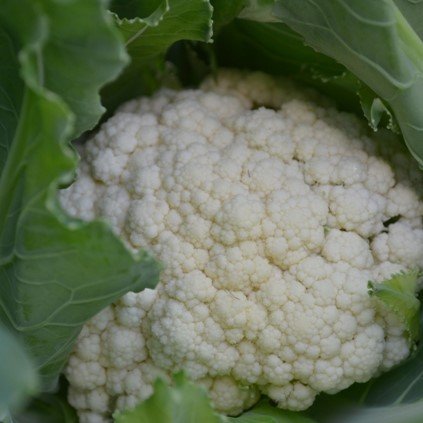Cauliflower – Snowball (Organic)
£2.30
A fantastic and versatile heritage cauliflower suited for all growing seasons. Snowball cauliflower was bred in the 1890s in America, and it has certainly stood the test of time. It produces heads of up to 15cm diameter ready 65-70 days from sowing. It has a mild flavour perfect for cooking but also delicious raw.
The plants are smaller than some cauliflowers and so can be planted closer together. We particularly love this variety due to its flexibility.
(Approximate seed count – 200)

In stock
| Month | J | F | M | A | M | J | J | A | S | O | N | D | ||||||||||||
|---|---|---|---|---|---|---|---|---|---|---|---|---|---|---|---|---|---|---|---|---|---|---|---|---|
| Sow | ||||||||||||||||||||||||
| Plant | ||||||||||||||||||||||||
| Harvest | ||||||||||||||||||||||||
Seed Sowing
Sow seeds from January to February undercover, or direct sow from March to May outdoors. For overwintering, sow in September to October in a cold frame or greenhouse. Cauliflowers are best grown in modules or a seed bed and then transplanted later.
Transplanting
Transplant your seedlings into their final growing position around 6 weeks after sowing. Remove any weeds and add plenty of organic matter before planting. Spacing depends on the variety; some smaller varieties require less space. When transplanting, firm them in well; they prefer to be tucked in tight. Protect them from frost if necessary.
Plant Care
Keep them constantly watered; hot weather and dry conditions may encourage bolting. Mulch with straw to retain water and prevent weed growth. Strong sunlight can cause cauliflowers to turn yellow; you can tie some larger leaves over the head to keep it white.
Challenges
Protect them from slugs and snails, use mesh to prevent damage from pigeons and caterpillars. Copper collars can be employed to ward off cabbage root fly. Clubroot is a disease affecting brassicas, causing deformed roots and stunted growth. If your soil has clubroot organisms, improve drainage and add lime to reduce infection or grow in pots.
Harvest
To harvest a good cauliflower, pick it when the head is still nice and compact before it starts to set flowers. Check regularly once heads start to form. Cut the stalk with a few small edible leaves attached. The main plant should go on to produce a few smaller baby cauliflowers from the stem.
Culinary Ideas
While you can’t beat good cauliflower cheese, there are plenty of great recipes involving this excellent carrier of flavor and spice. Try it marinated and roasted whole or in florets, steamed and wrapped in rice paper dipped into a spicy sauce, or use it in stir-fries and curries. It can be eaten raw in salads and made into piccalilli.
Seed Saving
Cauliflower belongs to the species Brassica oleracea and will cross with all other varieties within this species if not isolated from other flowering plants. They are a biennial seed crop and need a period of cold to make seeds, meaning you have to overwinter them. Choose at least twelve specimens that are true-to-type, healthy, and have shown disease resistance; avoid early bolters. Allow the plants to flower, get pollinated, and when the green seed pods begin to turn brown and the seeds inside black, cut the stem and leave to mature further on a sheet indoors. When fully dry, the seeds will easily fall out of their pods. You can stomp or stand on the material to help this, then sieve to remove the chaff.
